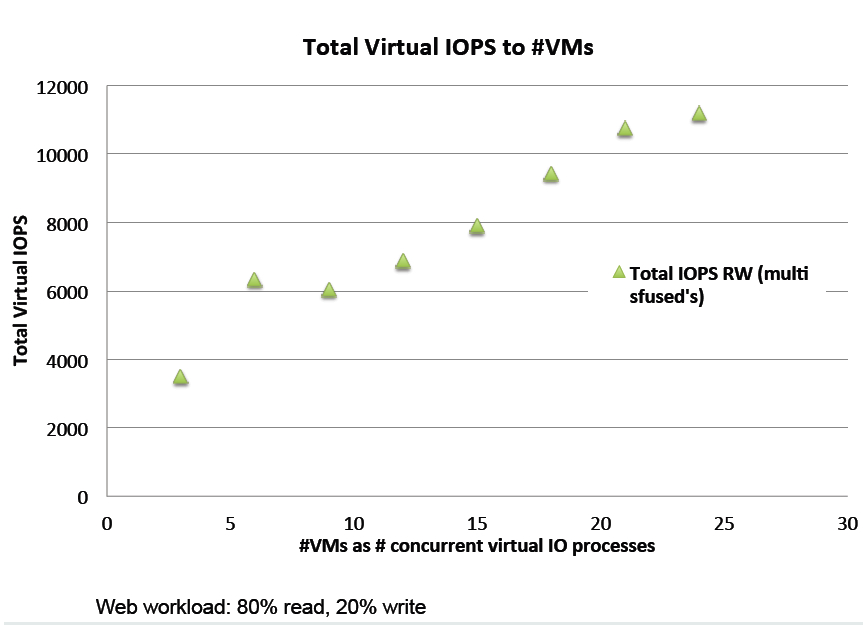Scality Ring V5.0 Software-Defined Storage
Introduces unified file, object, and VM storage for enterprise cloud, SaaS, cloud service providers.
This is a Press Release edited by StorageNewsletter.com on August 26, 2014 at 2:53 pmScality, Inc. announced at VMworld 2014 version 5.0 of its RING software.
It adds ‘Amazon EBS-like’ VM storage capabilities to enable enterprises and service providers to run multiple cloud storage workloads, across file, object and VM applications, in one single petabyte-scale storage environment.
Today’s RING is as much as 95% faster than last year’s edition for file operations and random IO, powering global enterprise cloud use cases such as enterprise NAS, file sync and share, and backup.
RING 5.0 performance matches Amazon EBS at 200 IO/s per VM, with bursting capabilities of 3,000 IO/s per VM, and scales out linearly to hundreds of thousands of VMs.
Unlike all flash arrays and VM storage appliances, which address different segments of the market, Scality offers unified storage for VM data and massive amounts of application data, for 10X lower cost per terabyte, and economies of scale. In petabyte-scale RING deployments, customers are getting VM storage for free. Through innovation within RING’s scale-out file system and database components, Scality now supports key value data, POSIX semantics, and byte-range changes in block volumes, diversifying usage across many workloads and applications. RING can be deployed on-premises for private cloud or in a hosted environment to provide cloud services.
RING 5.0 also advances Scality’s software-defined data center (SDDC) strategy by improving automation of deployment, installation, and management with support of standard DevOps tools and a redesigned GUI. This includes support of OpenStack Cinder to programmatically provision Scality VM storage.
“Given the current gold rush around software-defined ‘everything,’ it’s refreshing to see a storage approach that is grounded entirely in software,” said Simon Robinson, research VP of storage, 451 Research. “By offering a straight software play that supports multiple, enterprise workloads – supporting file, object and now VM-level access – on a single platform, Scality offers one of the most complete software-defined storage platforms we have seen to date. By using object storage as an enabling layer, complemented by native file system and VM storage access, they can not only deliver storage at massive scale, but also provide high performance for a variety of workloads.”
Growth of Scality in M&E, Cloud Services, and Financial Services
- Media and Entertainment companies are overwhelmed with petabytes of high-resolution media, and under attack from new business models. They are adopting software-defined storage to consolidate redundant delivery infrastructure, and scale to hundreds of petabytes efficiently. Scality helps new customers like Deluxe Entertainment, the premier post-production company, enhance their business with SDS.
- Web application and service providers are growing their businesses at double and triple digits, but competition is intense. They are adopting software-defined storage to eliminate redundant storage infrastructure, increase the ability to offer new services, and scale to hundreds of petabytes cost-competitively. Scality is working with new customers like QVC, a leading video and ecommerce retailer, and Dailymotion, the world’s second largest online video site, to upgrade their infrastructure for the next generation of services.
- Financial services companies are the vanguard of the SDDC, virtualizing the majority of their applications. Their storage strategy however is siloed, inefficient, and expensive to operate. They are adopting software-defined storage to provide a unified pool of limitless storage across multiple storage workloads to increase agility and reduce operating costs. Scality is now working with several of the world’s largest banks to extend their enterprise clouds with unified object and VM storage.
“The vision of the SDDC is rapidly becoming reality,” said Jérôme Lecat, CEO, Scality. “Our customers in financial services, media and entertainment, service providers, and other industries are looking for a pure software solution to be the storage foundation for their modern data centers. We are excited to provide that foundation with RING 5.0.“
Answers to questions about RING software
How is Scality different from object storage like Cleversafe?
RING is entirely software-based, and designed to support file, object, and block protocols in a single storage pool, including persistent block VM storage, without application customization, third party gateways, or storage appliance lock-in.
How is Scality different from scale out NAS like Isilon?
Scality’s software-based approach offers petabyte-scale storage at 50-70% lower cost. RING is designed to be 100% available with customizable, multi-geo failure domains, petabyte-scale data protection with only 29% overhead, and universal data access to a single limitless storage pool.
How can Scality address nearly 80% of storage workloads?
RING is unique in pairing a scale-out database to handle a range of different protocol interactions across file (POSIX), object (key value) and VM (block), with a parallel data architecture to support high bandwidth, high I/O, and low latency requirements in a single platform.
How does Scality support 100% availability?
RING runs at the application layer, which makes it independent from hardware and OS modifications and upgrades. Scality has a peer-to-peer topology to make it highly resilient to software and hardware failures. Scality also offers a configurable mix of replication, erasure coding, and geo-replication to tolerate disk, server, rack, and site failures.
How does Scality support cloud economics?
The combination of being hardware-agnostic, consolidating multiple workloads and applications, and scaling to petabytes with extremely HA translations into very low $/TB that decreases as the system scales.













 Subscribe to our free daily newsletter
Subscribe to our free daily newsletter
